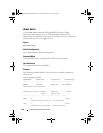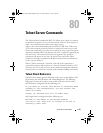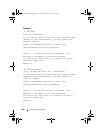
1744 System Management Commands
Example
Following is an example of using the telnet command to connect to
176.213.10.50.
console#telnet 176.213.10.50
Esc U sends telnet EL
traceroute
Use the traceroute command in Privileged EXEC mode to discover the IP
routes that packets actually take when traveling to their destinations.
Syntax
traceroute [ ip | ipv6 ]
ipaddress
|
hostname
[ initTtl
initTtl
] [ maxTtl
maxTtl
] [ maxFail
maxFail
] [ interval
interval
] [ count
count
] [ port
port
]
[ size
size
][source {<src-ip-address>|vlan <vlan-id>|loopback <loop-
id>}]
Parameter Description
Parameter Description
ipaddress Valid IP address of the destination host.
hostname
Hostname of the destination host. (Range: 1–158 characters).
The command allows spaces in the host name when specified in
double quotes. For example,
console(config)#snmp-
server host "host name"
initTtl The initial time-to-live (TTL); the maximum number of router
hops between the local and remote system (Range: 0–255).
maxTtl The largest TTL value that can be used (Range:1–255).
maxFail Terminate the traceroute after failing to receive a response for
this number of consecutive probes (Range: 0–255).
interval The timeout period. If a response is not received within this
period of time, then traceroute considers that probe a failure
(printing *) and sends the next probe. If traceroute does receive
a response to a probe, then it sends the next probe immediately.
(Range: 1–60 seconds).
2CSPC4.X8100-SWUM102.book Page 1744 Friday, March 15, 2013 8:56 AM


















